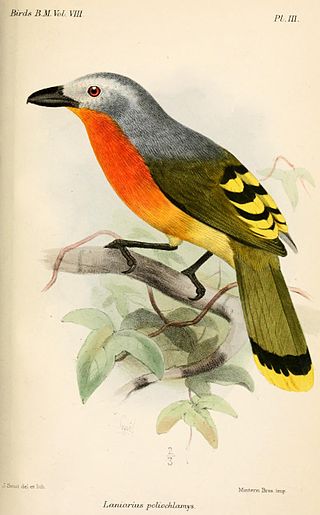
Amaranthus is a cosmopolitan group of more than 50 species which make up the genus of annual or short-lived perennial plants collectively known as amaranths. Some of the more well known names include "prostrate pigweed" and "love lies bleeding". Some amaranth species are cultivated as leaf vegetables, pseudocereals, and ornamental plants.

Senecio is a genus of flowering plants in the daisy family (Asteraceae) that includes ragworts and groundsels.

The blood pheasant or blood partridge is a galliforme bird in the pheasant family Phasianidae and the only species in the genus Ithaginis. It is a relatively small, short-tailed pheasant that is widespread in the lower Himalayas ranging across North and East India, Nepal, Bhutan, South China and northern Myanmar. It has been classified as Least Concern on the IUCN Red List since 2009, and the global blood pheasant population is thought to be stable.

Amaranthus cruentus is a flowering plant species that is native from Central Mexico to Nicaragua. It yields a nutritious staple amaranth grain, being one of three Amaranthus species cultivated as a grain source, the other two being Amaranthus hypochondriacus and Amaranthus caudatus. It has several common names, including blood amaranth, red amaranth, purple amaranth, prince's feather, and Mexican grain amaranth.

Species belonging to the genus Amaranthus have been cultivated for their grains for 8,000 years. Amaranth plants are classified as pseudocereals that are grown for their edible starchy seeds, but they are not in the same botanical family as true cereals, such as wheat and rice. Amaranth species that are still used as a grain are Amaranthus caudatus L., Amaranthus cruentus L., and Amaranthus hypochondriacus L. The yield of grain amaranth is comparable to that of rice or maize.

Amaranth is a reddish-rose color that is a representation of the color of the flower of the amaranth plant. The color shown is the color of the red amaranth flower, but there are other varieties of amaranth that have other colors of amaranth flowers; these colors are also shown below.

The crimson-breasted finch, also known as the crimson finch-tanager, is a species of small finch-like bird native to woodland and scrub of western Ecuador and adjacent north-western Peru. It is the only member of the genus Rhodospingus. It has traditionally been placed in the family Emberizidae, but molecular phylogenetic studies have shown that it belongs to the tanager family Thraupidae. It is strongly sexually dichromatic, with males being blackish above and rich orange-red below and on the crown, while females are overall dull greyish-buff.

Pristimantis cruentus is a species of frog in the family Strabomantidae, sometimes known as the Chiriqui robber frog. It is found in Costa Rica, Panama, and north-western Colombia. Its natural habitats are forests, including humid lowland and montane forests. It can also be found in degraded habitats outside forests. It is threatened by habitat loss.

The white-headed vanga is a species of bird in the family Vangidae. It is monotypic within the genus Artamella. It is endemic to Madagascar, where its natural habitats are subtropical or tropical dry forest, subtropical or tropical moist lowland forest, and subtropical or tropical moist montane forest.

The fiery-breasted bushshrike is a species of bird in the family Malaconotidae. It is found throughout the African tropical rainforest. Its natural habitats are subtropical or tropical dry forest and subtropical or tropical moist lowland forest.

The rosy-patched bushshrike is a species of bird in the family Malaconotidae. It is monotypic within the genus Rhodophoneus. It is found in Djibouti, Egypt, Eritrea, Ethiopia, Kenya, Somalia, Sudan, and Tanzania. Its natural habitat is subtropical or tropical dry shrubland.

Ichthyodectes is an extinct genus of ichthyodectid fish which lived during the Late Cretaceous. Fossils of the species included have been found from Canada to Texas.

Zermizinga is a moth genus in the family Geometridae erected by Francis Walker in 1863. Species within this genus include Zermizinga sinuata, the lucerne looper or spider moth, which was described by Warren in 1897, as well as Zermizinga indocilisaria, which was described by Walker in 1863.

Wet rot is a generic term used to define a variety of fungal species, such as Coniophora puteana and Choanephora cucurbitarum. Some species obtain their food by breaking down the cell walls of wood, resulting in a loss of its strength. This can cause problems in the structural integrity of structures. The species C. cucurbitarum affects the flowers and fruit of crops, such as amaranthus and okra.

Quedius is a genus of large rove beetles in the family Staphylinidae. There are about 800 described species in Quedius.

Chimarra is a genus of little black caddisflies in the family Philopotamidae. There are more than 630 described species in Chimarra.
Odontopsammodius is a genus of aphodiine dung beetles in the family Scarabaeidae. There are about 12 described species in Odontopsammodius.
Xenochalepus is a genus of tortoise beetles and hispines in the family Chrysomelidae. There are more than 90 described species in Xenochalepus.

Oplomus is a genus of predatory stink bugs in the family Pentatomidae. There are about nine described species in Oplomus.
Pachybrachis cruentus is a species of case-bearing leaf beetle in the family Chrysomelidae. It is found in North America.















